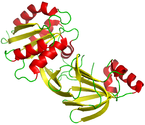- Diacylglycerol kinase
-
Diacylglycerol kinase catalytic domain Identifiers Symbol DAGK_cat Pfam PF00781 Pfam clan CL0240 InterPro IPR001206 SMART DAGKc Available protein structures: Pfam structures PDB RCSB PDB; PDBe PDBsum structure summary Diacylglycerol kinase accessory domain Identifiers Symbol DAGK_acc Pfam PF00609 InterPro IPR000756 SMART DAGKa Available protein structures: Pfam structures PDB RCSB PDB; PDBe PDBsum structure summary Prokaryotic diacylglycerol kinase Identifiers Symbol DAGK_prokar Pfam PF01219 InterPro IPR000829 PROSITE PDOC00820 Available protein structures: Pfam structures PDB RCSB PDB; PDBe PDBsum structure summary Diacylglycerol kinase (DGK or DAGK) is a family of enzymes that catalyzes the conversion of diacylglycerol (DAG) to phosphatidic acid (PA) utilizing ATP as a source of the phosphate. In non-stimulated cells, DGK activity is low allowing DAG to be used for glycerophospholipid biosynthesis but on receptor activation of the phosphoinositide pathway, DGK activity increases driving the conversion of DAG to PA. As both lipids are thought to function as bioactive lipid signaling molecules with distinct cellular targets, DGK therefore occupies an important position, effectively serving as a switch by terminating the signalling of one lipid while simultaneously activating signalling by another.[1]
In bacteria, DGK is very small (13 to 15 kD) membrane protein which seems to contain three transmembrane domains.[2] The best conserved region, is a stretch of 12 residues which are located in a cytoplasmic loop between the second and third transmembrane domains. Some Gram-positive bacteria also encode a soluble diacylglycerol kinase capable of reintroducing DAG into the phospholipid biosynthesis pathway. DAG accumulates in Gram-positive bacteria as a result of the transfer of glycerol-1-phosphate moieties from phosphatidylglycerol to lipotechoic acid [3].
DGK Isoforms
Currently, nine members of the DGK family have been cloned and identified. Although all family members have conserved catalytic domains and two cysteine rich domains, they are further classified into five groups according to the presence of additional functional domains and substrate specificity.[4] These are as follows:
- Type 1 - DGK-α, DGK-β, DGK-γ - contain EF-hand motifs and a recoverin homology domain
- Type 2 - DGK-δ, DGK-η - contain a pleckstrin homology domain
- Type 3 - DGK-ε - has specificity for arachidonate-containing DAG
- Type 4 - DGK-ζ, DGK-ι - contain a MARCKS homology domain, ankyrin repeats and a nuclear localisation signal
- Type 5 - DGK-θ - contains a third cysteine-rich domain, a pleckstrin homology domain and a proline rich region
References
- ^ Merida I, Avila-Flores A, Merino E (2008). "Diacylglycerol kinases: at the hub of cell signalling.". Biochem. J. 409 (1): 1–18. doi:10.1042/BJ20071040. PMID 18062770.
- ^ Smith RL, O'Toole JF, Maguire ME, Sanders CR (September 1994). "Membrane topology of Escherichia coli diacylglycerol kinase". J. Bacteriol. 176 (17): 5459–65. PMC 196734. PMID 8071224. http://www.pubmedcentral.nih.gov/articlerender.fcgi?tool=pmcentrez&artid=196734.
- ^ Miller DJ, Jerga A, Rock CO, White SW (July 2008). "Analysis of the Staphylococcus aureus DgkB structure reveals a common catalytic mechanism for the soluable diacylglycol kinases". Structure 16 (7): 1036–46. doi:10.1016/j.str.2008.03.019. PMID 18611377.
- ^ Van Blitterswijk, WJ, and Houssa, B (2000). "Properties and functions of diacylglycerol kinases.". Cellular Signaling 1 (9-10): 595–605. PMID 11080611.
External links
Transferases: phosphorus-containing groups (EC 2.7) 2.7.1-2.7.4:
phosphotransferase/kinase
(PO4)Hexo- · Gluco- · Fructo- (Hepatic) · Galacto- · Phosphofructo- (1, Liver, Muscle, Platelet, 2) · Riboflavin · Shikimate · Thymidine (ADP-thymidine) · NAD+ · Glycerol · Pantothenate · Mevalonate · Pyruvate · Deoxycytidine · PFP · Diacylglycerol · Phosphoinositide 3 (Class I PI 3, Class II PI 3) · Sphingosine · Glucose-1,6-bisphosphate synthase2.7.2: COOH acceptor2.7.6: diphosphotransferase
(P2O7)2.7.7: nucleotidyltransferase
(PO4-nucleoside)DNA-directed DNA polymerase: DNA polymerase I · DNA polymerase II · DNA polymerase III holoenzyme
DNA nucleotidylexotransferase/Terminal deoxynucleotidyl transferase
RNA-directed DNA polymerase: Reverse transcriptase (Telomerase)RNA nucleotidyltransferaseRNA polymerase/DNA-directed RNA polymerase: RNA polymerase I · RNA polymerase II · RNA polymerase III · RNA polymerase IV · Primase · RNA-dependent RNA polymerase
PNPaseUridylyltransferaseGlucose-1-phosphate uridylyltransferase · Galactose-1-phosphate uridylyltransferaseGuanylyltransferasemRNA capping enzymeOther2.7.8: miscellaneous PhosphatidyltransferasesCDP-diacylglycerol—glycerol-3-phosphate 3-phosphatidyltransferase · CDP-diacylglycerol—serine O-phosphatidyltransferase · CDP-diacylglycerol—inositol 3-phosphatidyltransferase · CDP-diacylglycerol—choline O-phosphatidyltransferaseGlycosyl-1-phosphotransferase2.7.10-2.7.13: protein kinase
(PO4; protein acceptor)see tyrosine kinasessee serine/threonine-specific protein kinases2.7.12: protein-dual-specificitysee serine/threonine-specific protein kinases2.7.13: protein-histidineAnabolism to diacylglycerol: Acyltransferase · Phosphatidate phosphatase (2C)
Choline kinase (CHKA, CHKB) · Choline-phosphate cytidylyltransferase
phosphatidylinositol glycan anchor biosynthesis: (PIGA, PIGB, PIGC, PIGF, PIGG, PIGH, PIGK, PIGL, PIGM, PIGN, PIGO, PIGP, PIGQ, PIGS, PIGT, PIGU, PIGV, PIGW, PIGX, PIGY, PIGZ)
cardiolipin: TafazzinCatabolism Diacylglycerol kinase (DGKA, DGKB, DGKD, DGKE, DGKG, DGKH, DGKI, DGKK, DGKQ, DGKZ)
Phosphoric monoester hydrolases · Inositol-phosphate phosphataseThis transferase article is a stub. You can help Wikipedia by expanding it.

